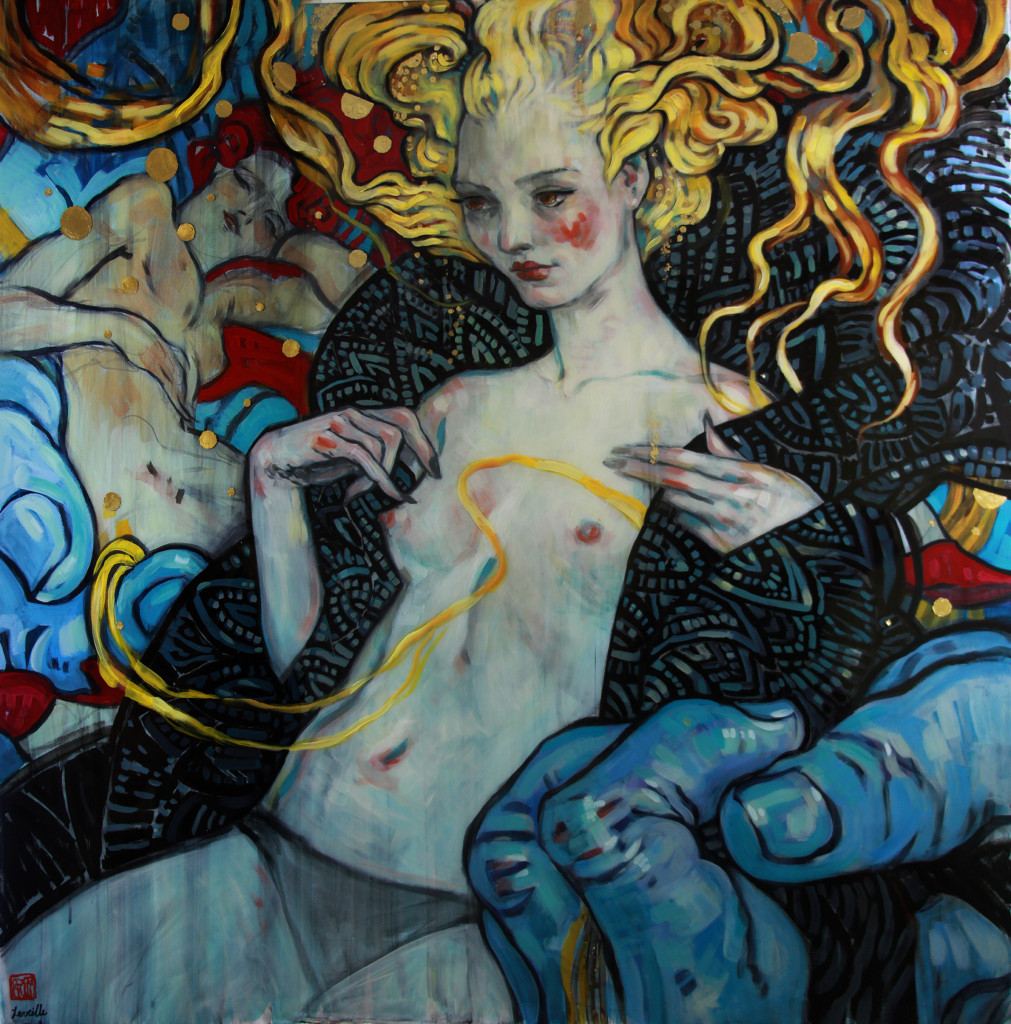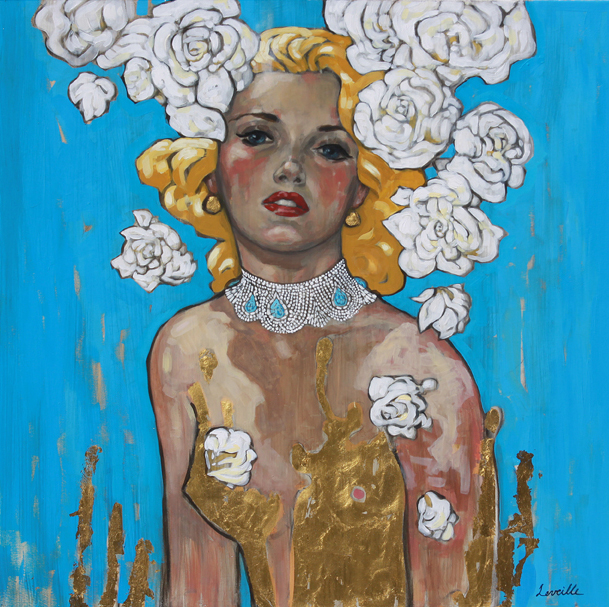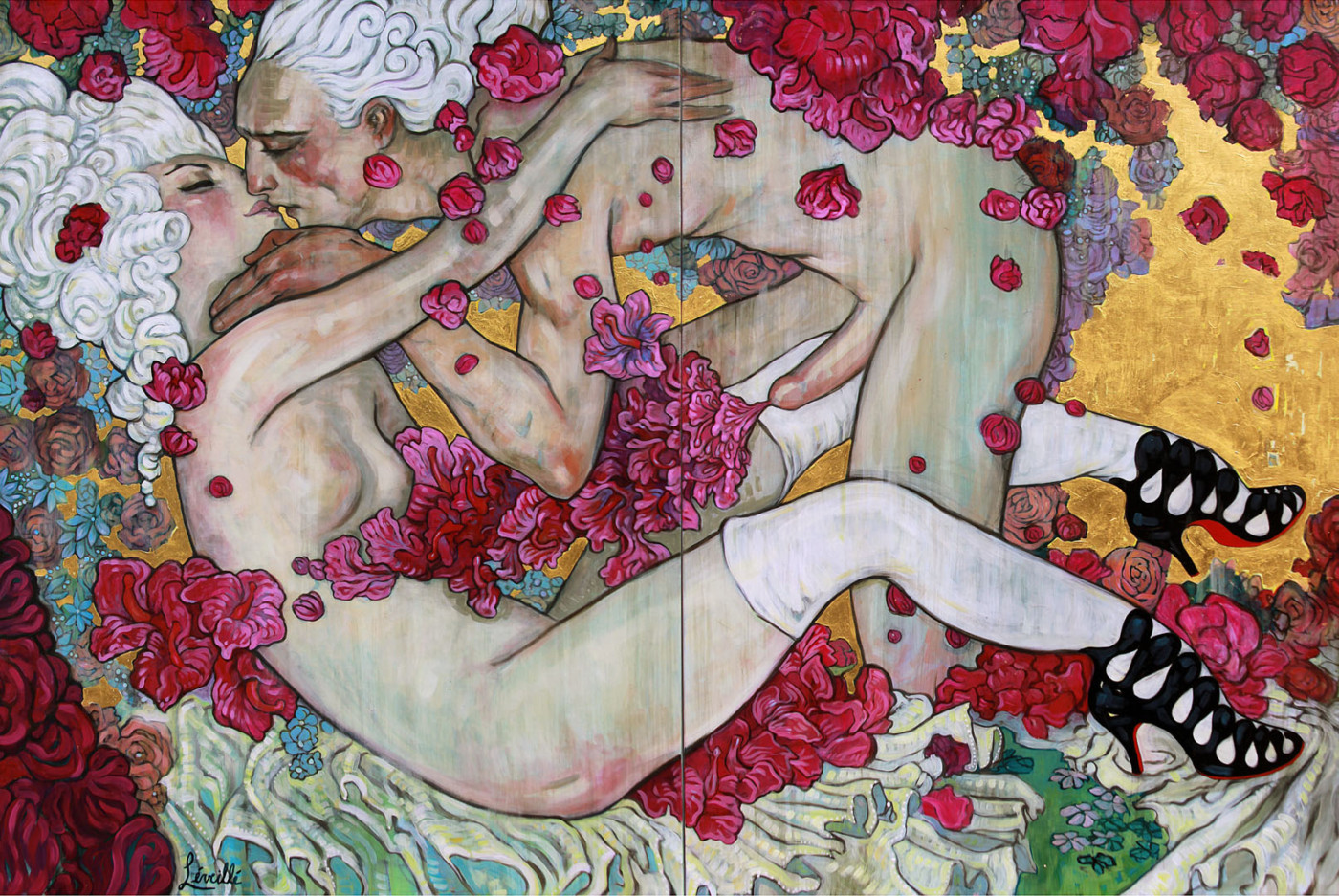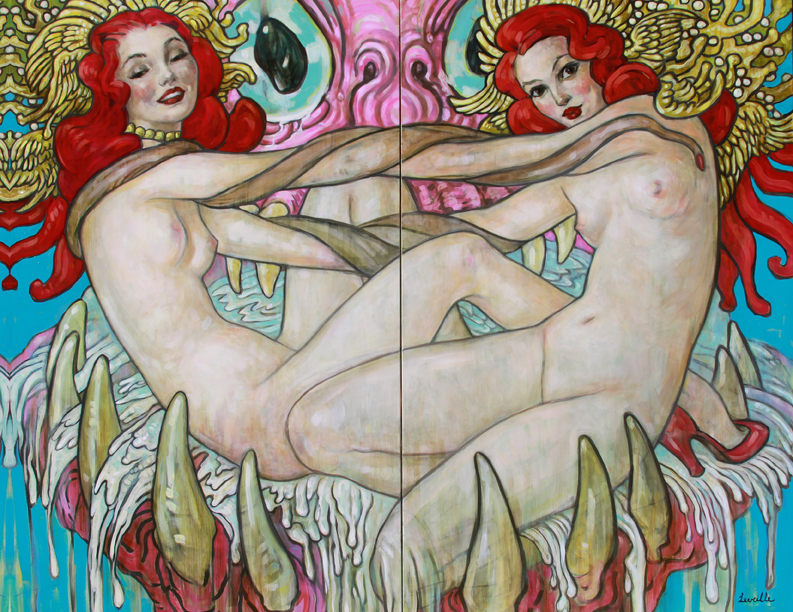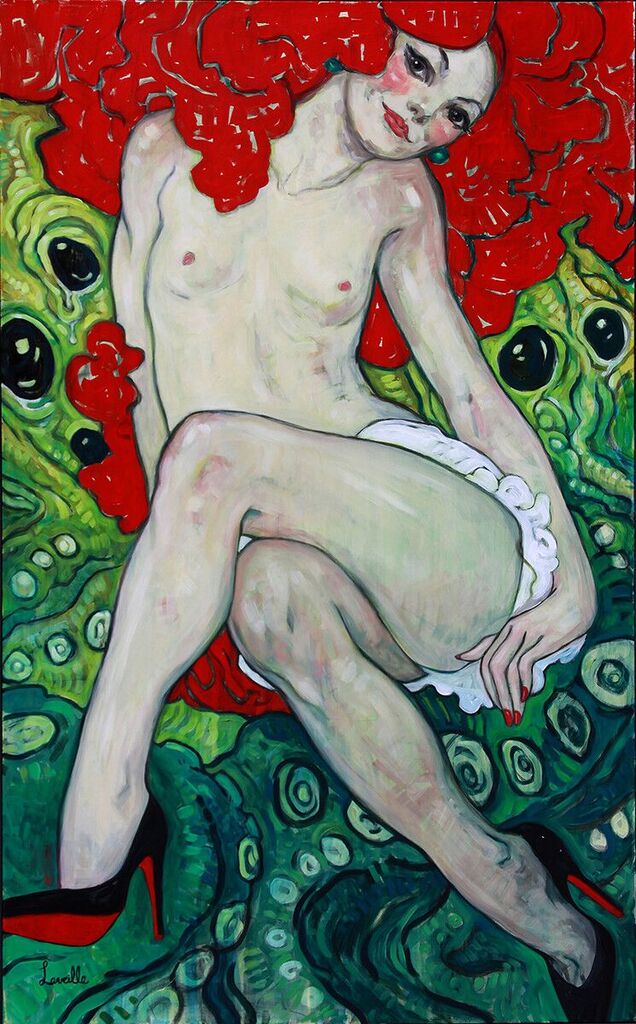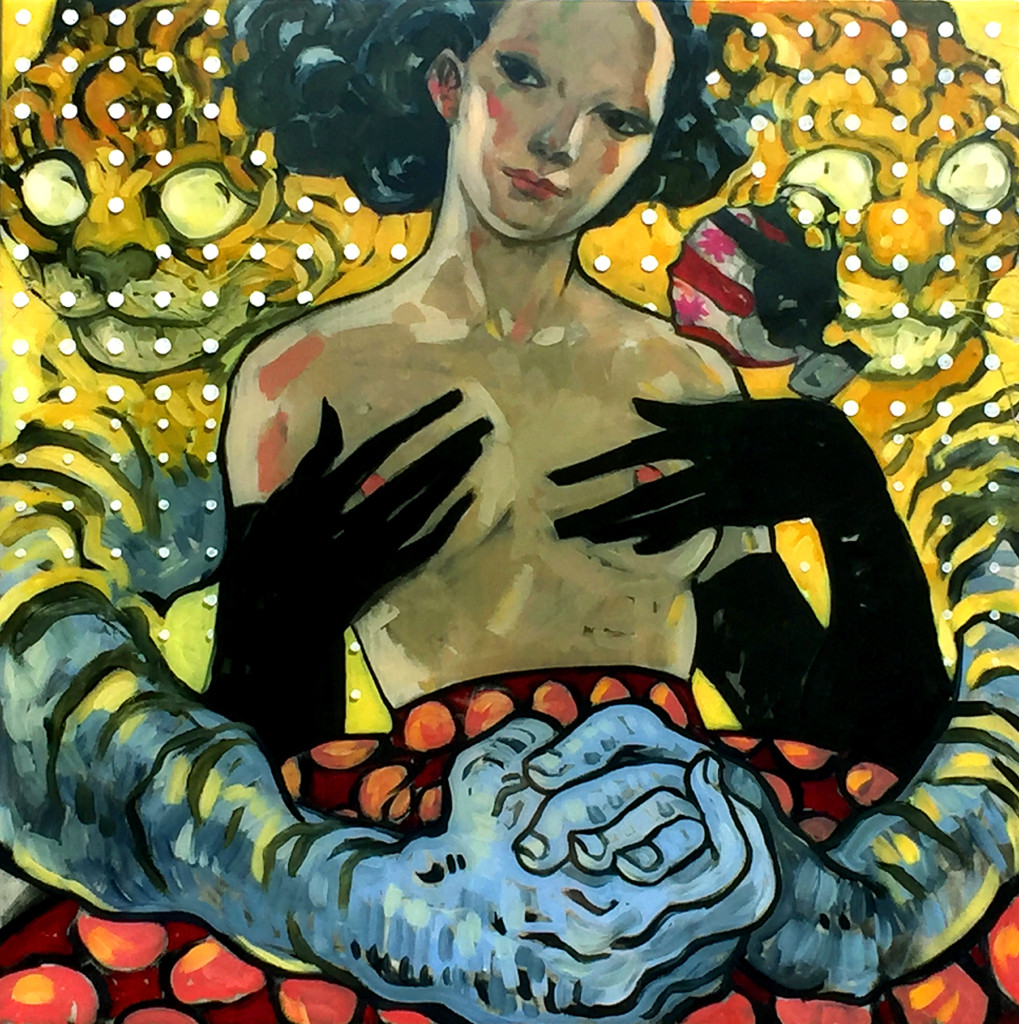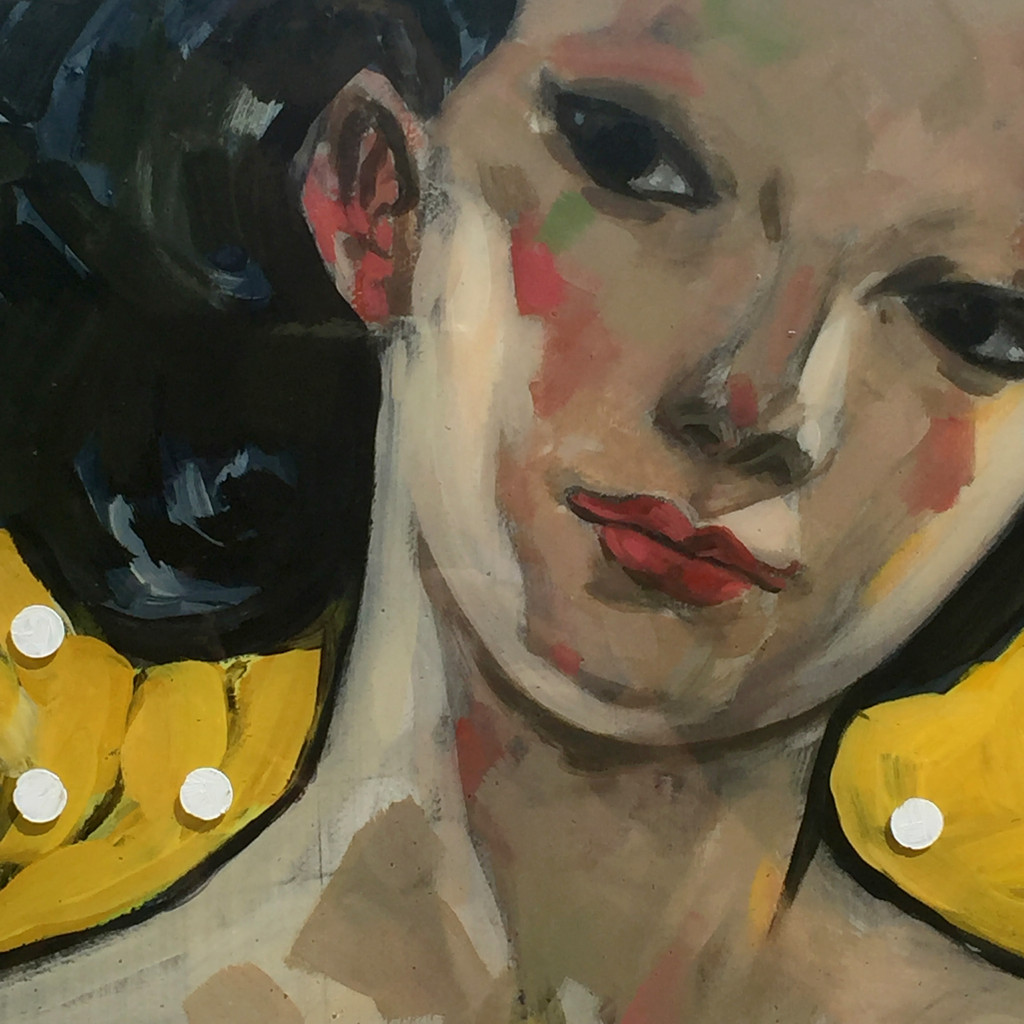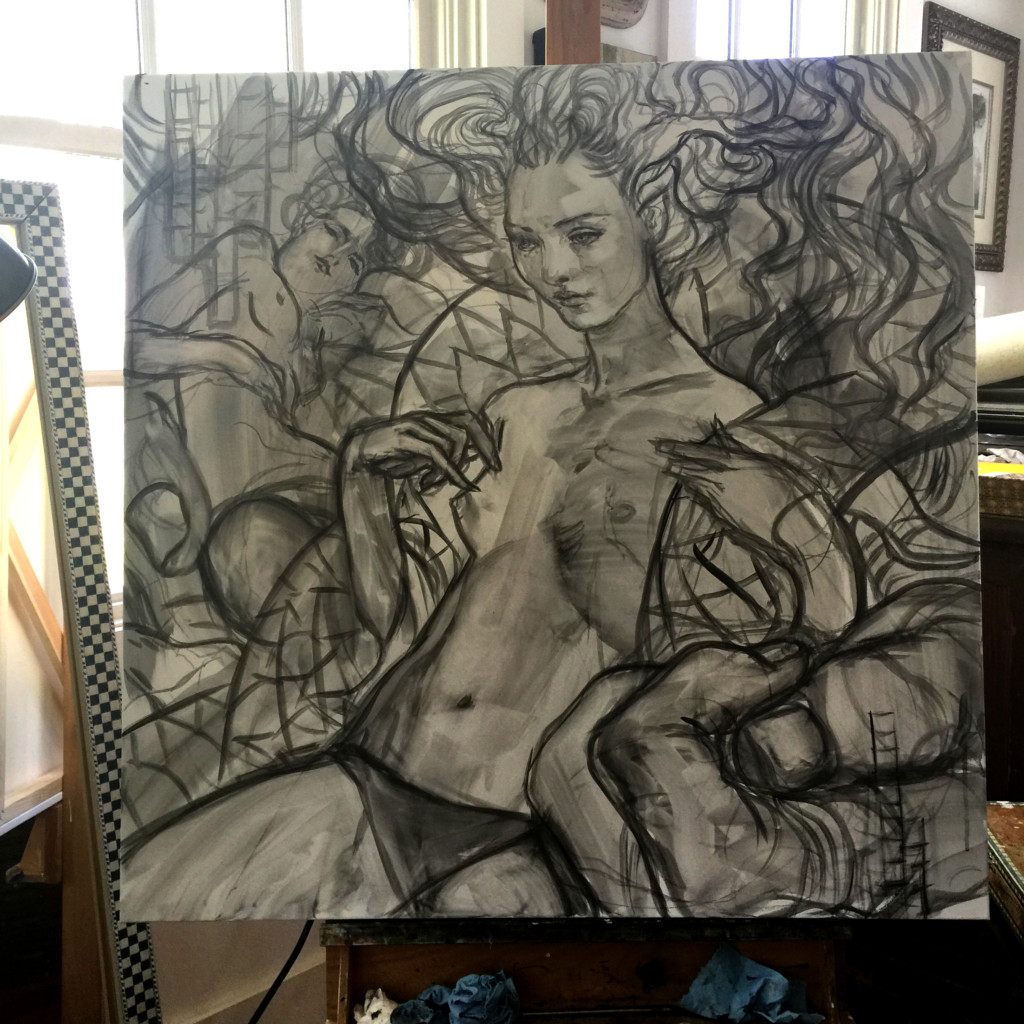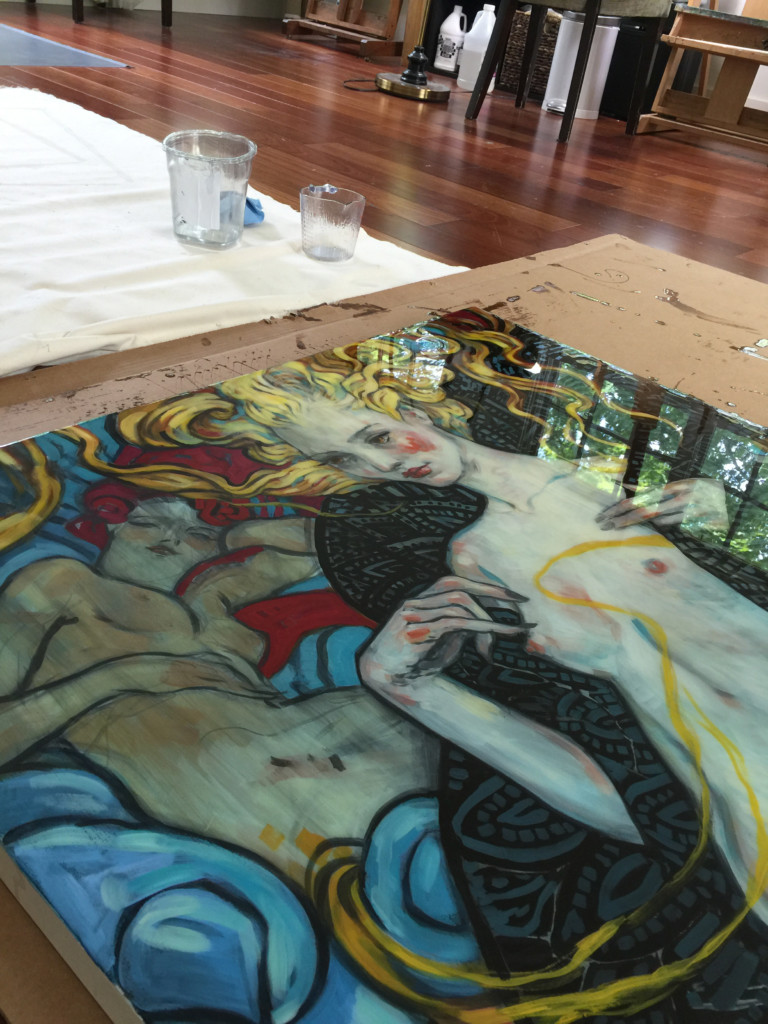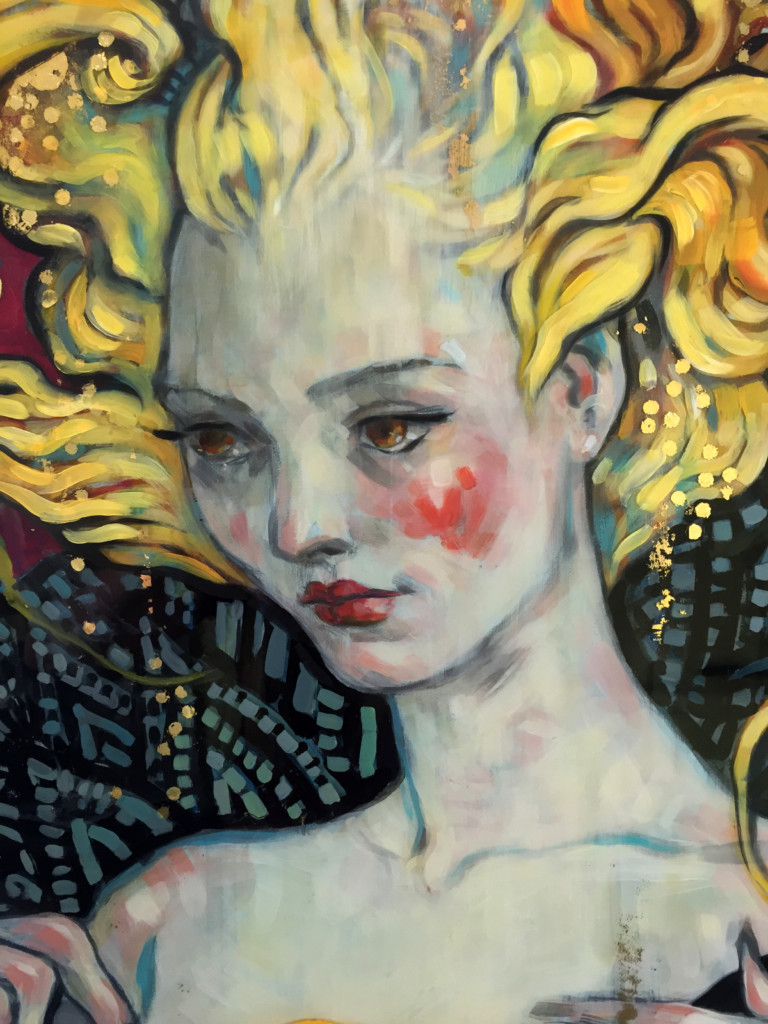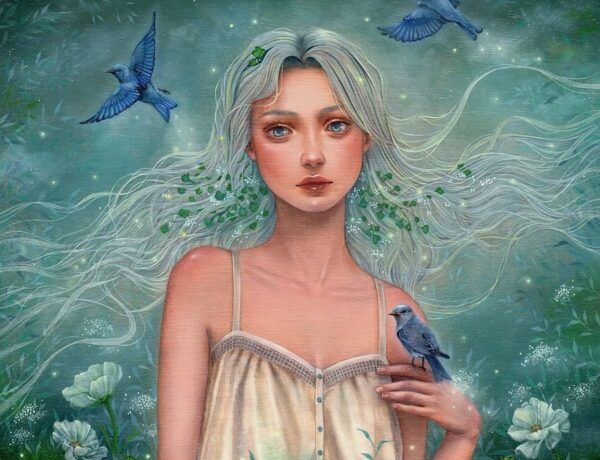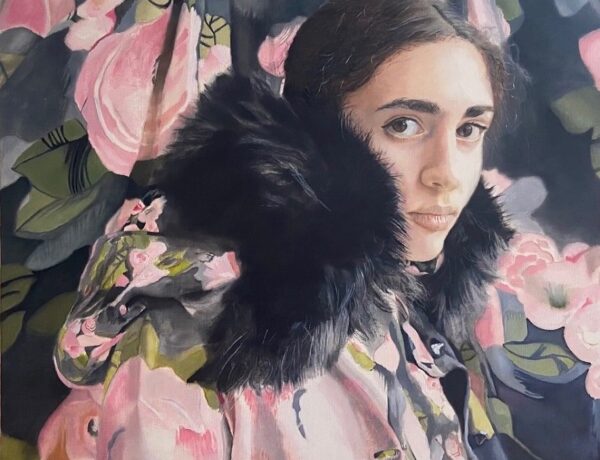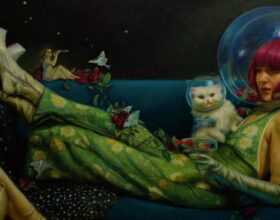Hailing from North Boston and currently residing in Massachusetts, Rebecca Leveille-Guay seamlessly blends renaissance masters and ethereal themes to create lavish tragedies, delightful whimsy and effortless natural beauty on canvas. Her pieces are mosaic-like in structure but sensual and provocative in style. The graphite under-drawing and transparent graphite washes beneath give way to oiled layers, and substantial brushwork to create visions of raw and beautiful creatures. Within these works you can see Leveille’s influences: Lautrec, Gerda Wegener, Titian, Waterhouse, John Curran and Jim Shaw and Lisa Yusksavage.
Having successfully opened her first solo exhibit in September 2013 at the R. Michelson Gallery, Guay’s most recent exhibition (in March of this year) was the ‘Savage Garden’ exhibit, at Corey Helford, Los Angeles. Having been met with critic and fan acclaim, I dive into the reasons and motivations behind Savage Garden, and get a sneak-peek at Rebecca’s up-and-coming works for CHG 10th Anniversary Group Show on view August 27 – September 24, 2016, as well as for the Delaware Art Museum Show that will run September 23 – 25, 2016.
‘Give me Pretty Things’
‘Wet Gardenia’ – Oil and gold leaf
Lee: For those who may not know, what is Savage Garden?
Rebecca: Savage Garden was the title of my solo show at Corey Helford Gallery in Los Angeles this past March. It was my first show in LA, which was very exciting for me as I very much admire what’s going on in the LA art world. Although I’d done a group show with CHG in 2015, and will have a large piece in the 10th anniversary show in August, Savage Garden was also my first solo show with CHG.
L: Taking on such an exhibit must have been painstaking and a challenge in itself, how do you plan for such a project as this?
R: You don’t really plan, you just do. A great deal of the making of the show comes about out of the process of being in the studio every day committing to the work. Inspiration finds you working.
L: Was the process for this project a lonely process? If so, what did you do to counteract this?
R: Always lonely but full of internal voices! In a good way. Paintings really do start “talking” to you as you’re making them- and you have to leave your mind to be open to the dialogue that occurs because its from that fertile place that the next piece comes from.
Once I’m working on a piece (have decided the idea, emotion, intention, have the underpainting in place) for which I need total silence then I usually shift to podcasts or audiobooks to keep myself pinned down. It also helps to stop my mind from wandering. There’s a time for letting you mind wander and a time for buckling down to the finish. If I let my mind wander as it would with music or silence towards the second part of a painting. I’d never finish anything because I’d always be getting new ideas and keep changing the current piece. I’ve learned that if I get a new idea while working I jot it on a post it and use it for the next piece rather than trying to fit it into the current one.
‘Acrobat’
L: Did you pick up any bad habits during this process?
R: Breaking too much for coffee…getting overly of obsessed with how many “likes” I have gotten from Jerry Saltz for my work on instagram (6 likes and counting!). These are bad habits. Both end up making you jittery but they also feel too good to stop.
L: (laughs). In your career you’ve worked in all manner of artistic mediums, from children’s stories, graphic novels to fantasy card games, what triggered the transition to a focus on gallery shows?
R: I owe a great debt to comics/graphic novels and fantasy card games like Magic for that. The fact that when I shifted to gallery I had actual “fans” from those places- many whom have followed me to the gallery work. I changed my name after the 2013 show from Guay to Leveille (also a family name) though, to give the personal work a chance to stand in its own right, separate from illustration. I have great respect for both worlds, but illustration is often connected to a style guide that someone else created or a sale of a product, that’s its intention, and in that way frequently one is only saying a small portion of what’s in their artistic heart, it’s a collaboration with passion but also with product in mind. I found that I would do a whole series of new works from a very personal place, and then a new MTG (Magic the Gathering) card set would come out and the internet would be flooded all over again with a painting I’d done, for someone else’s character, intention, goals, product, often one I’d done in my twenties often in a style that I no longer work in and the new work would get overshadowed by the juggernaut of the commercial illustration and innate popularity of the game itself. Again, I was thankful and have been thankful for the popularity of the game, its meant a lot for many artists, including myself but the new work deserved a chance to exist without that, have its own place.
I left illustration though so I could truly paint the things I most wanted to paint. No matter how wonderful the job in illustration you get is there’s always someone else dictating the terms either through style guide or a manuscript or what the market will or will not buy and I wanted to make art without those confines. I wanted to paint with my whole heart and full intention and that meant gallery work.
L: What prior themes led you up to the Savage Garden Show? When looking at your previous works such as the ‘The Visitor’ for example, it seems you are able to seamlessly blend renaissance masters and ethereal themes to create these sensual and provocative works but why did you choose these themes?
R: Leading up to the body of work that became the Savage Garden Show, in the prior east coast shows I had delved more directly into reinterpreting a sort of renaissance aesthetic with contemporary symbolism. This is evidenced very clearly in the Visitor painting from my 2013 show “Waking” with R. Michelson. The subtle melancholy of that piece and the unfurling imagery of the octopus was successful because to the emotional connection one gets with the viewer and the facial expression of the main figure. The secondary symbol of the octopus is rather a representation of the unconscious visitor- the dark things that settle in our minds and influence us.
‘The Visitor’ – Oil on canvas
L: Moving into the heart of the project, why Savage Garden? Why not something else?
R: To go into detail about what the Savage Garden show means, requires some back-story. I’ve always been an artist dealing with beauty and sensuality. It’s the drive behind the work. The Waking show was very much about sensuality and sexuality.
In 2014, because of some very personal experiences, I started to examine the feeling of deep duality that I had with beauty, and the almost angry feelings I have toward society and what it does to women around beauty. As a woman, how I myself have felt the pressure to maintain a physical ideal of beauty, to the determent of my own health. I know other women, many of them who have also struggled greatly with this. I actually suffered some very serious side effects to something related to a seemingly benign cosmetic related medication (one that is in extremely common use) that stopped my ability to work for almost a year, affected my vision, my nervous system, my heart, blood pressure, actually made me fear that I’d not be able to work again, and that I might have affected my health forever. Thankfully I’ve recovered to about 85% of my former self (I still suffer nervous system side effects) but was left with deep and very dark feeling of duality on the nature of beauty… my deep love and deep conflict with it.
The “Savage Garden” is what the world is for women to me; also, beauty is a Savage Garden. Beauty is not benign or placid, it is terrible and wonderful and dangerous, and powerful and worth asking questions about. The show is beginning to ask those questions. The Monsters painting with the beautiful terrible pin up aesthetic and the monstrous, (yet deceptively pink) creature that holds them is a good example of how I’m asking these questions. Almost every work in the show has active rather than passive gaze that’s said in a velvety way with ownership of their own image. This appropriation of the pin up aesthetic, forced deliberately through my own intention as a women was a way to own the pin up, the ultimate commercial sexualisation of women, as a woman artist, with recognition and critique of it.
The 1000 years of the male gaze in art, so prevalent the sensualisation for the female form from the masculine perspective. Even female artists have adopted the sensualized feminine almost from a masculine perspective, often without awareness that they are. Also this issue is connected in tandem with the issues of beauty in the show. The Flowers painting, boldly and without shame, is a highly sexualized male form from the perspective of the female gaze.
‘Flowers’
L: That’s very brave and honest of you. I can imagine you received some great responses to your Savage Garden exhibition! Do you have any memorable responses?
R: I loved the response I got to Flowers! At first, people are enticed by all the flowers and then they begin to understand the origin of the flowers and usually blush or laugh with delight but then keep looking and enjoying the painting. Flowers is meant to deal with sexuality, but it’s not “erotic art” it not meant for people to “get off on” it’s a celebration of male sexuality from a female perspective the same way the seductive rosy breasted (with evident signs of feminine arousal) female nude from Titian to Curran celebrate sex and the female from the male perspective.
L: And being a huge Batman fan, I’ve got to ask about that piece in particular; can you tell me a little about it?
R: Well, that’s Larry Gagosian of course…. and who else could he be, in my world of popular symbolism, but Batman! Doesn’t he seem like Batman to you?! I could go deep into what the whole piece-the Unrealism Triptych means- it’s really chocked full- but I think it’s actually more fun to just look and see what it means to the viewer.
L: (Laughs) He really does, now you mention it! And finally, thank you for taking the time to indulge my curiosity. If any of our readers want to keep up-to-date with what you’re doing, where can they follow/find you?
R: It has been my pleasure! They absolutely can follow me through my website as well as on Instagram.
‘Monsters’
‘Iriza d’orsay’
Be sure to check out Rebecca’s upcoming exhibitions at the Delaware Art Museum Show, September (23 – 25h, 2016) and the CHG 10th Anniversary show, (August 27 – September 24, 2016).
Rebecca has been kind enough to provide a few seductive teasers for these shows.
‘The Prisoner’
‘The Prisoner’ – Detail
‘Give me pretty things’ – Under-drawing
‘Give me Pretty Things’ – Progress
‘Give me Pretty Things’ – face detail
‘Savage’ – Under-drawing
‘The Blind’ – Under-drawing



